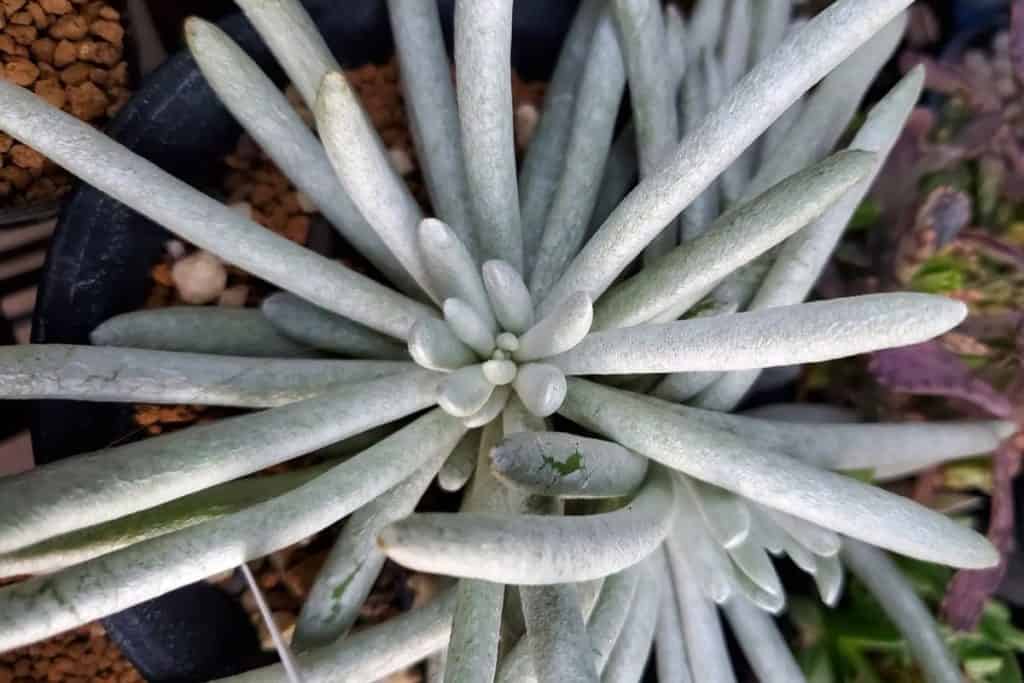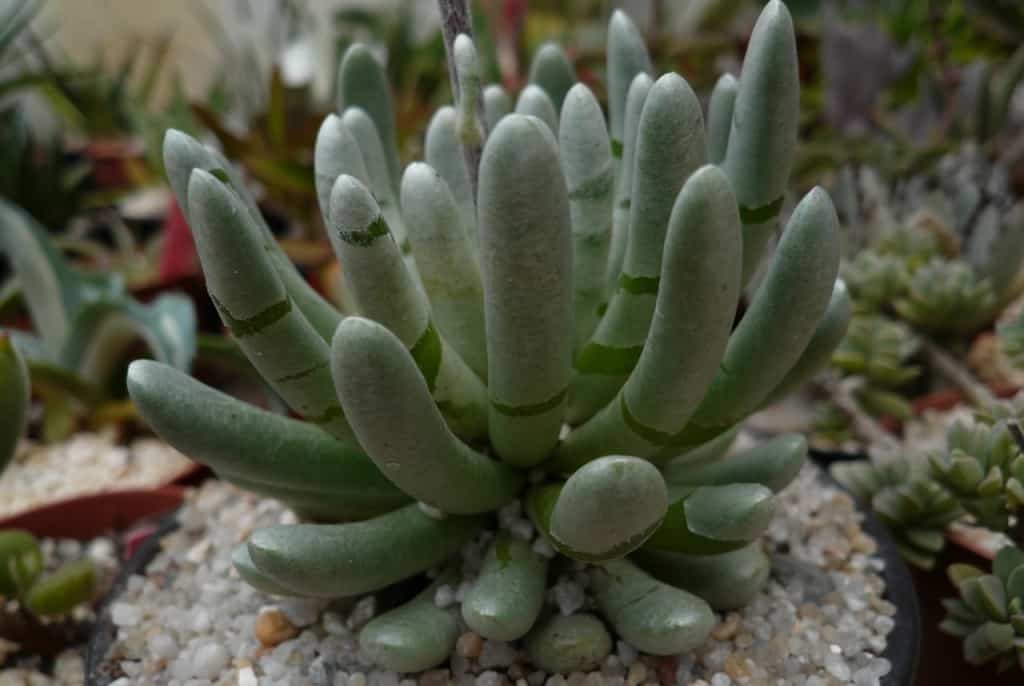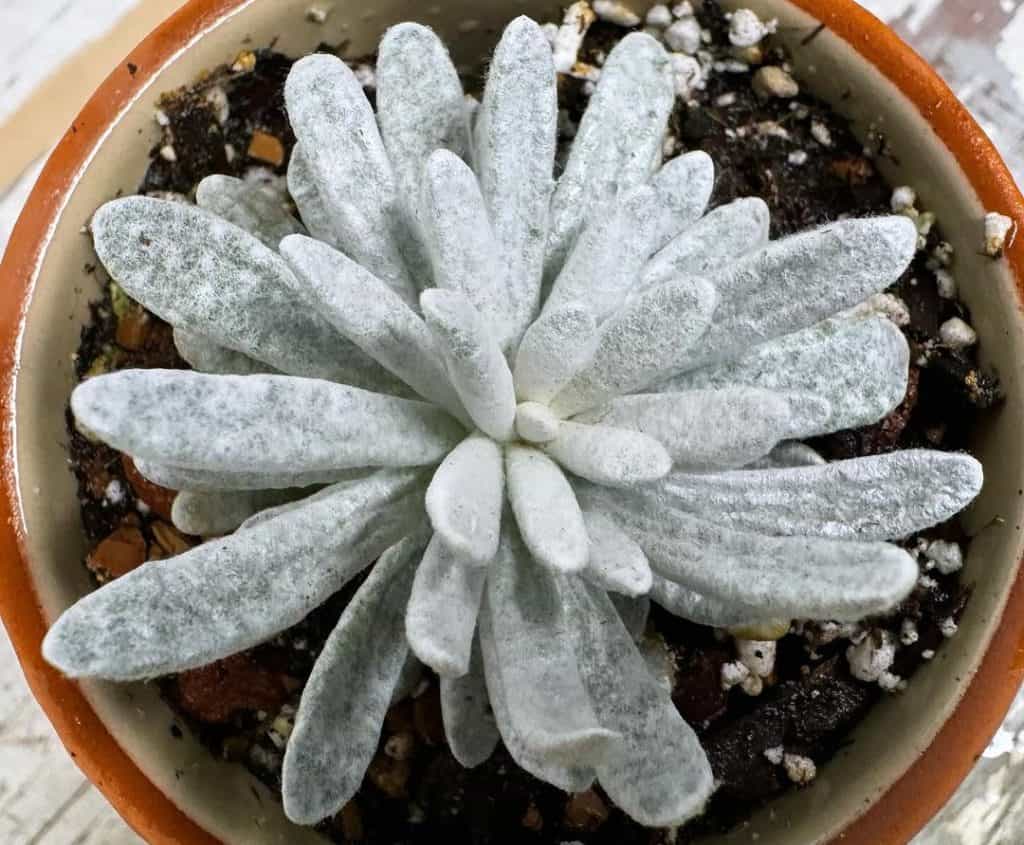Senecio scaposus: Characteristics and Care
Are you searching for a unique and eye-catching addition to your succulent collection? Look no further than the Senecio scaposus, a captivating succulent that will leave you spellbound with its silvery foliage and alluring woolly texture. Imagine running your fingers through its soft, fuzzy leaves – it’s an experience that will make you fall in love with this enchanting plant!

Contents
About Senecio scaposus
Senecio scaposus, also known as the woolly senecio or silver coral, is a mesmerizing succulent native to the Eastern and Western Cape regions of South Africa. This member of the Asteraceae family boasts a distinctive appearance, with its stem either absent or barely visible, and its cylindrical, bean-like leaves growing in a clustered or rosette pattern. The leaves are adorned with a captivating silver-green hue, thanks to their thick, woolly coating.
Related Post:
24 Senecio Lower Classifications [With Pictures]
How to Care For Senecio scaposus
Light Requirements
This silvery succulent thrives in bright, indirect sunlight, especially in hotter climates. However, if you reside in cooler regions, ensure that your Senecio scaposus receives ample full sunlight. Avoid exposing it to hot or cold drafts, as these can be detrimental to its well-being. If natural light is scarce, consider using a grow light to provide the necessary illumination for your woolly wonder.
Watering Needs
As a succulent, Senecio scaposus is remarkably drought-resistant, thanks to its ability to store water in its foliage. Overwatering can be disastrous, causing the leaves to burst, so it’s crucial to allow the soil to dry out completely before watering again. During the growing season (spring to fall), water your Senecio scaposus once every 1-2 weeks, and reduce the frequency to once a month during the winter months.
Keep an eye out for visual cues: if the leaves appear wrinkled or deflated, it’s time to water your plant. However, be cautious, as overwatered succulents can mimic the appearance of underwatered ones. To differentiate, gently touch the leaves – if they feel slimy, reduce watering, but if they’re dry and crisp, the soil likely needs moisture.

Soil Requirements
Senecio scaposus thrives in well-draining, sandy soil with a neutral pH range of 6 to 7. When potting your plant, choose a cactus or fast-draining succulent mix to ensure optimal drainage and prevent root rot.
Fertilizer Needs
While Senecio scaposus can grow well in sandy soil, providing a mild fertilizer during the spring and summer months can give it an extra nutritional boost. Be cautious not to over-fertilize, as this can cause the plant to become leggy and unattractive.
Temperature and Humidity
Senecio scaposus is well-suited for USDA hardiness zones 9 to 12, thriving in warm temperatures and tolerating heat well. However, prolonged exposure to cold or damp conditions can cause the plant to turn mushy and unhealthy. During the winter months, it’s best to bring your Senecio scaposus indoors to protect it from the cold.
Pests and Problems
While generally resilient, Senecio scaposus can occasionally fall victim to mealybugs and scale insects. Keep an insecticidal soap or neem oil on hand and treat any infestations promptly.

Pruning
Pruning is typically unnecessary for Senecio scaposus, except for removing diseased or dead foliage. If you have a taller species and prefer a more compact shape, you can prune the plant back to the stem.
Potting and Repotting
Senecio scaposus plants thrive in containers, making them ideal for indoor cultivation or for mixing with other succulents in outdoor gardens. Choose a pot with drainage holes, preferably made of unglazed ceramic or terra cotta, and fill it with a well-draining potting mix.
Repotting is recommended every 12 to 18 months, or when the roots begin to protrude from the drainage holes. This is an opportune time to provide your plant with fresh soil and a larger pot to accommodate its growth.
Senecio scaposus Propagation Methods

Senecio scaposus can be easily propagated through several different methods, allowing you to multiply your collection of these charming woolly succulents.
Division
One of the simplest ways to propagate Senecio scaposus is through division. This method works well for mature plants that have formed multiple offshoots or “pups” around the base.
- Carefully remove the plant from its pot and gently separate the offshoots from the parent plant, ensuring each division has its own root system.
- Allow the wounded areas to callous over for a few days before replanting the divisions in fresh, well-draining soil.
- Water sparingly until new growth appears, indicating the divisions have taken root.
Stem Cuttings
For species of Senecio scaposus with visible stems, propagation through stem cuttings is an effective method.
- Using a sharp, sterile knife or scissors, take 3-4 inch stem cuttings, making clean cuts just below a leaf node.
- Allow the cut ends to callous over for several days.
- Dip the calloused ends in a rooting hormone powder to encourage root development.
- Plant the treated cuttings in a well-draining potting mix, burying the bottom third of the cutting in the soil.
- Water sparingly and provide bright, indirect light until new growth appears.
Seeds
While less common, Senecio scaposus can also be propagated from seeds, offering an opportunity to grow new plants from scratch.
- Sow the seeds in a well-draining seed-starting mix, covering them with a thin layer of soil.
- Keep the soil consistently moist but not waterlogged.
- Provide bright, indirect light and warm temperatures until the seeds germinate.
- Once seedlings have developed their first set of true leaves, transplant them into individual pots with a succulent or cactus potting mix.
No matter which propagation method you choose, Senecio scaposus is a rewarding plant to cultivate, and propagating your own specimens allows you to share the beauty of these woolly wonders with fellow enthusiasts.
